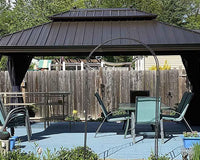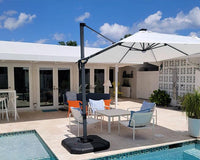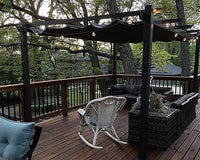Imagine this: you're enjoying a perfect afternoon on your patio when a few clouds roll in and a light drizzle begins. Your first thought might bae, "Great, my patio umbrella is about to save the day!" But then comes the second thought: "Is this thing, which I bought for sun, actually okay to use in the rain? Will I ruin it?"
It’s a really good question. We buy patio umbrellas to give us shade, so it’s natural to wonder if they can pull double duty as a rain shelter. The short answer is: yes, but with some very important exceptions. This guide will walk you through when it’s safe to keep your umbrella open and when you absolutely need to close it up.
Know What Your Umbrella Is Made Of
Whether your patio umbrella can handle rain comes down to its "hardware"—the fabric of the canopy and the material of the frame and pole.
The Canopy: "Water-Resistant" vs. "Waterproof"
This is the most important difference. The two terms sound alike, but they mean very different things.
- Water-Resistant(or water-repellent): This is what most patio umbrellas are. The fabric (usually polyester or acrylic) has been treated to make water bead up and roll off. In a light shower, this is totally fine and will keep you dry. But if the rain gets heavy or lasts a long time, the water will eventually soak through.
- Waterproof: This means the material itself, like a raincoat, won't let water through at all. Some very high-end umbrellas might have this, but it’s not common.a
So, you can pretty much assume your umbrella is water-resistant. It’s meant to handle a passing shower, not act like a permanent roof.
The Frame: Aluminum, Steel, or Wood?
The frame is the "bones" of your umbrella, and how it handles getting wet is important.
- Aluminum: This is the most worry-free option. Aluminum doesn't rust, so getting it wet is no big deal, though learning how to care for outdoor aluminum furniture can make it last even longer. It's a great choice for rainy climates.
- Steel: Steel is very strong, but it can rust. Most steel frames have a powder-coated finish to protect them. As long as that coating isn't scratched or chipped, it will keep rust away. But if the coating gets damaged, the exposed steel will start to rust.
- Wood: A wooden frame looks beautiful, but it's also the most "needy." The wood needs a good sealant to protect it. If that sealant wears off, water can seep in and cause the wood to swell, crack, or even rot over time.

When It's Totally Fine to Use Your Umbrella in the Rain
Once you know what your outdoor umbrella is made of, you can figure out when it's okay to use it as a cozy shelter.
Light Showers and Drizzles
This is the perfect time to use your patio umbrella in the rain. When it’s just a light drizzle or a passing shower that you know will end soon, go ahead and open it up. The water-resistant canopy can handle this kind of rain easily, giving you and your patio furniture a nice dry spot to wait it out.
Brief, Moderate Rain
Imagine you're having a barbecue and a sudden, medium-strength shower starts. This is where your umbrella can be a party-saver. It can provide a temporary shelter, giving you enough time to get the food inside or just wait for the rain to pass without everyone getting soaked and running for the door.

When You Absolutely Need to Close the Umbrella
Knowing when you can use your umbrella is great, but knowing when you can't is even more important. Pushing your luck in the wrong weather can damage your umbrella and even be dangerous.
Heavy Downpours
Remember, your patio umbrella is not a boat. When it's raining cats and dogs, the huge amount of water can cause big problems. It can pool on top of the canopy, and that extra weight can stretch the fabric or even bend the umbrella's ribs. A heavy downpour will also wear off the water-resistant coating on the fabric much faster.
Anytime It's Windy! (The Most Important Warning)
This is the most important rule of all: wind is the number one enemy of a patio umbrella. An open umbrella is basically a giant sail. Even a moderate breeze can create a ton of force. If your base isn't heavy enough, a gust of wind can easily knock the whole thing over, damaging your table, chairs, or even hurting someone.
If the wind is stronger, it gets much worse. A strong gust can snap the ribs, tear the canopy, or even launch the entire umbrella into the air like a dangerous kite. So, here’s the simple rule: if it's windy, close the umbrella. Immediately.
During Snow or Hail
This might sound like a no-brainer, but it needs to be said. Patio umbrellas are absolutely not designed to hold the weight of snow. Wet snow is incredibly heavy, and letting it pile up on your umbrella will almost certainly cause the frame to break. Hail is even worse; it can easily punch holes right through the fabric. In the winter, your umbrella should be closed and stored away.
The Most Important Thing to Do After the Rain: Let It Dry!
So the rain has stopped, and your umbrella did its job. But you're not done yet. If you want your umbrella to last a long time and not get moldy or musty, this next step is crucial.
Never, ever close up a wet umbrella and put the cover on. Trapping moisture in a dark, closed-off space is a perfect recipe for mold and mildew. Once you get those ugly spots on the fabric, they're almost impossible to get rid of.
The right thing to do is: after the rain stops, leave the umbrella open until it is completely dry. Find a sunny, breezy spot if you can, and just let it air out. Once you can touch the inside and outside and it feels totally dry, then you can close it up and put it away.

Three Tips to Make Your Umbrella More "Rain-Friendly"
While your umbrella isn't built for a hurricane, you can do a few things to make it a little tougher in the rain.
- Use a Water-Repellent Spray: At the start of the season, you can give the canopy a quick spray with a fabric water-repellent (like Scotchgard). This will help the water bead up and roll off even better.
- Invest in a Heavy Base: A heavy patio umbrella with base (at least 50 lbs / 23 kg) is key to keeping your umbrella from tipping over in a light breeze.
- Do a Quick Check-Up: Every now and then, take a look at your umbrella. If it has a steel frame, check for scratches and touch them up with a little rust-proof paint. If it's wood, make sure the sealant still looks good.
Keeping Your Patio Umbrella Safe and Durable
So, can you use your patio umbrella in the rain? The answer is yes—as long as it’s a gentle rain with no wind. Think of it as a temporary shelter for a light drizzle, not a permanent fortress against a storm. Always put safety first, especially when it's windy. And taking the time to let it dry out completely after it gets wet is a simple habit that, along with other outdoor umbrella maintenance tips, will make your favorite umbrella last for many more sunny—and drizzly—days to come.





